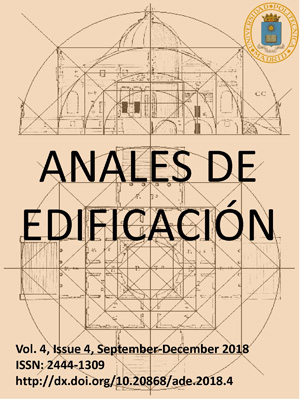Estudio de los radios de curvatura mínimos de los cortes de bambú. Análisis experimental con Phyllostachys bambusoidesSieb. et Zucc = Study of the permissible bending radius of bamboo cuts. Experimental analysis with Phyllostachys bambusoidesSieb. et Zucc.
DOI:
https://doi.org/10.20868/ade.2018.3848Resumen
Resumen
Con el objetivo de determinar la relación existente entre los cortes admisibles de una caña de bambú que se asocian a una determinada parte anatómica de la planta y el comportamiento mecánico a flexión que se evidencia con el radio de curvatura admisible, se realizaron ensayos experimentales con 5 cortes longitudinales de 1,25m de longitud de bambú de la especie PhyllostachysbambusoidesSieb. et Zucc., de dos años de edad. Se observó que la cara externa de la caña de bambú presenta mayor resistencia a flexión que la cara interna, obteniendo un radio de curvatura menor con las probetas de la cara externa del bambú ensayado. El radio de curvatura mínimo que se obtuvo en los ensayos fue de 191º correspondiente al corte de 1/8 de de bambú que presentaba una parte de la cara externa y otra de la cara interna, equilibrando su constitución anatómica. Las condiciones físico - anatómicas de las plantas, tanto su composición como la ley intrínseca que establece su disposición, determinan su comportamiento mecánico.
Abstract
In order to determine the relationship between the permissible cuts of a bamboo cane that are associated with a certain anatomical part of the plant and the mechanical bending behaviour that is evidenced by the permissible radius of curvature, experimental tests were carried out with 5 longitudinal cuts of 1.25 m length of bamboo of the species Phyllostachys bambusoidesSieb. et Zucc., two years old. It was observed that the outer face of the bamboo cane presents greater resistance to bending than the inner face, obtaining a smaller radius of curvature with the specimens of the outer face of the bamboo tested. The minimum radius of curvature obtained in the tests was 191º corresponding to the cut of 1/8th of bamboo that presented a part of the external face and another of the internal face, balancing its anatomical constitution. The physical and anatomical conditions of the plants, both their composition and the intrinsic law that establishes their arrangement, determine their mechanical behaviour.
Descargas
Referencias
Grosser, D., & Liese, W. (1971). On the anatomy of Asian bamboos, with special reference to their vascular bundles. Wood Science and technology, 5(4), 290–312.
Liese, W. (1987). Research on bamboo. Wood Science and Technology, 21(3), 189–209.
Liese, W. (1992). The structure of bamboo in relation to its properties and utilization. Zhu, S., Li, W., Zhang, X. Wang, Z. ed., Bamboo and its use. Proceedings of the International symposium on Industrial Use of Bamboo, Beijing, China, 7–11.
Liese, W. (1994). Biological aspects of bamboo and rattan for quality improvement by polymer impregnation. Folia Forestalia Polonica, Seria B, Zeszyt, 25.
Liese, W. (1996). Structural research on bamboo and rattan for their wider utilization. Journal of bamboo research, 15(2), 1–14.
Liese, W. (1998). The anatomy of bamboo culms (Vol. 18). Brill.
Lima, D. M. (2013). Bambu laminado colado (Dendrocalamus giganteus) aplicado à treliça plana tipo Howe e à viga retangular.
Londoño, X., Camayo, G., Riaño, N., & López, Y. (2002). Caracterización anatómica del culmo de Guadua angustifolia Kunth. Seminario-Taller Avances sobre la investigación sobre Guadua.
López, L. F., & Correal, J. F. (2009). Estudio exploratorio de los laminados de bambú Guadua angustifolia como material estructural. Maderas. Ciencia y tecnolog
Lopez, O. H. (2003). Bamboo: The gift of the gods. O. Hidalgo-Lopez.
Shanmughavel, P., Peddappaiah, R., Liese, W., & others. (2003). Recent advances in bamboo research. Scientific Publishers (India).
Sharma, B., Gatóo, A., Bock, M., & Ramage, M. (2015). Engineered bamboo for structural applications. Construction and Building Materials, 81, 66–73.
Sharma, B., Gatóo, A., & Ramage, M. H. (2015). Effect of processing methods on the mechanical properties of engineered bamboo. Construction and Building Materials, 83, 95–101.
Descargas
Publicado
Número
Sección
Licencia
1. Los autores conservan los derechos de autor y garantizan a la revista el derecho de una Licencia Creative Commons Atribución - Nocomercial 4.0 Internacional que permite a otros compartir el trabajo con un reconocimiento de la autoría y uso no comercial.
2. Los autores pueden establecer por separado acuerdos adicionales para la distribución no exclusiva de la versión de la obra publicada en la revista (por ejemplo, situarlo en un repositorio institucional o publicarlo en un libro).
Salvo indicación contraria, todos los contenidos de la edición electrónica se distribuyen bajo una licencia de uso y distribución “Creative Commons"












